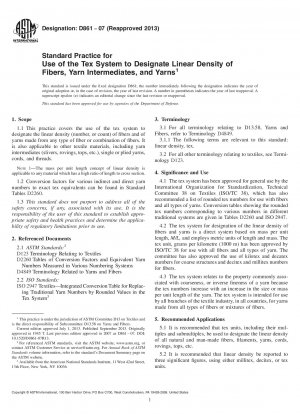ASTM D861-07(2013)
Standard Practice for Use of the Tex System to Designate Linear Density of Fibers, Yarn Intermediates, and Yarns
- Standard No.
- ASTM D861-07(2013)
- Release Date
- 2007
- Published By
- American Society for Testing and Materials (ASTM)
- Status
- Replace By
- ASTM D861-07(2018)
- Latest
- ASTM D861-07(2018)
- Scope
4.1 The tex system has been approved for general use by the International Organization for Standardization, Technical Committee 38 on Textiles (ISO/TC 38), which has also recommended a list of rounded tex numbers for use with fibers and all types of yarns. Conversion tables showing the rounded tex numbers corresponding to various numbers in different traditional systems are given in Tables D2260 and ISO8201;2947.
4.2 The tex system for designation of the linear density of fibers and yarns is a direct system based on mass per unit length, M/L, and employs metric units of length and mass. The tex unit, grams per kilometre (1000 m) has been approved by ISO/TC 38 for use with all fibers and all types of yarn. The committee has also approved the use of kilotex and decatex numbers for coarse structures and decitex and millitex numbers for fibers.
4.3 The tex system relates to the property commonly associated with coarseness, or inverse fineness of a yarn because the tex numbers increase with an increase in the size or mass per unit length of the yarn. The tex system is intended for use by all branches of the textile industry, in all countries, for yarns made from all types of fibers or mixtures of fibers.
1.1 This practice covers the use of the tex system to designate the linear density (number, or count) of fibers and of yarns made from any type of fiber or combination of fibers. It is also applicable to other textile materials, including yarn intermediates (slivers, rovings, tops, etc.), single or plied yarns, cords, and threads.
1.2 Conversion factors for various indirect and direct yarn numbers to exact tex equivalents can be found in Standard Tables D2260.
ASTM D861-07(2013) Referenced Document
- ASTM D123 Standard Terminology Relating to Textiles
- ASTM D2260 Standard Tables of Conversion Factors and Equivalent Yarn Numbers Measured in Various Numbering Systems
- ASTM D4849 Standard Terminology Related to Yarns and Fibers
- ISO 2947 Textiles; Integrated conversion table for replacing traditional yarn numbers by rounded values in the Tex System
ASTM D861-07(2013) history
- 2018 ASTM D861-07(2018) Standard Practice for Use of the Tex System to Designate Linear Density of Fibers, Yarn Intermediates, and Yarns
- 2007 ASTM D861-07(2013) Standard Practice for Use of the Tex System to Designate Linear Density of Fibers, Yarn Intermediates, and Yarns
- 2007 ASTM D861-07 Standard Practice for Use of the Tex System to Designate Linear Density of Fibers, Yarn Intermediates, and Yarns
- 2001 ASTM D861-01a Standard Practice for Use of the Tex System to Designate Linear Density of Fibers, Yarn Intermediates, and Yarns
- 2001 ASTM D861-01 Standard Practice for Use of the Tex System to Designate Linear Density of Fibers, Yarn Intermediates, and Yarns
- 1995 ASTM D861-95 Standard Practice for Use of the Tex System to Designate Linear Density of Fibers, Yarn Intermediates, and Yarns
